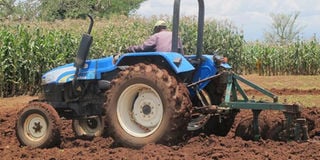Understanding farm tractors

A tractor ploughs a garden ahead of a new season. Below is a John Deere tractor on display. Photo Alex Esagala
What you need to know:
- In crop farming, tractors, ploughs, planters, tillers and harrowers, among others, are essential as they facilitate better farming. If farmers in Uganda hope to succeed in their agricultural initiative, they must yearn to embrace mechanised agriculture, writes Lominda Afedraru.
Mechanisation of agriculture has the potential to contribute to increased productivity, quality and increased quantity of agricultural produce.
Therefore in order to holistically appreciate productivity particularly in Uganda, it is important for farmers to know that there is a link between capital intensive production system, economic growth and mechanisation. In order to maximise the growth potential for agriculture in Northern Uganda a mechanised system approach should then be implemented by farmers and other stakeholders involved in the value chain.
This is the call of experts from Northern Uganda – Transforming the Economy through Climate Smart Agribusiness (NU - TEC) which is implementing use of mechanised agriculture in Northern Uganda in a five year project funded by DFID.
Collins Apuoyo, the team leader explaining the importance of farmers embracing mechanised agriculture notes that they carried out a study in the Northern Uganda and realized there is existing demand by farmers for use of tractors to plough their land, sow seed and implement weeding.
Tractor
A tractor is a vehicle designed to give high tractive effort at low speeds for the purposes of hauling agricultural implements. Tractors are generally classified by the number of axles or wheels, with main categories being two-wheel tractors (single-axle tractors) and four-wheel tractors (two-axle tractors). Among four-wheel tractors, most are two-wheel drive; but many are two-wheel drive with front wheel assist, four-wheel drive (often with articulated steering), or track tractors (with steel or rubber tracks).
Clearing and ploughing
Robert Acac from Ladwong Farming Ltd explains that farmers are aware that through mechanisation farm production increases.
The following steps must be followed by farmers;
• Farmers must embark on clearing the bush and uproot trees in order to level the land ready for ploughing.
• The tractor must be operated by skilled persons and this person must have knowledge about the machine and how it operates. In case of any break down, he or she must be able to fix certain spare parts.
• He or she must know the farm implements ranging from blades, weeders and planters among others.
• It is important for the tractor operator to understand the landscape. If the land is slope he or she must avoid ploughing of the land from the top because this will lead to causing soil erosion. The tractor operator in this case has to plough the land diagonally.
Weeding
Weeders operate well with crops planted in rows. Inter-row cultivation and field crop weeders are best used for weeding. This means several row crops need to have the space between the rows cultivated during the lag phase of the crop to avoid overgrowing of weeds.
Besides, such operations can be combined with the application of fertilisers banded or spread between the rows for particular crops. In most cases the weeders have rippers to break the hard soil which is spread even beneath the plants. The field for forages and cereals can be implemented using mechanical weed control which is simplified using the tined weeders during and after the growth phase of crops. Various tine size and frame widths are available.
Harvesting
In most cases farmers engaged in large scale commercialised agriculture hire a combined harvester which is a machine with its own implements and harvesting operations.
This will carry out operations of cutting the crop, crashing and weaving thereby delivering clean seed.
Planting
There are different types of planters depending on the farmer’s choice of preference but in most case the pneumatic closing wheels are recommended because it is able to effect seed to soil contact which plays a vital role in plant growth.
It is important for the machine operator to fix the bucket for the seed and for fertiliser application.
The bucket for fertiliser is usually fixed in front of the one for seed because fertiliser has to be dropped in the hole before planting seed.
The planters automatically calculate the amount of seed to be dropped per hole depending on the type of crop.
Seed-to-soil contact plays as vital a role in plant growth as any component of successful planting and it has a proper closing system. It also operates well during harsh conditions such as breaking hard soils when the rains are scarce.
It is worthwhile investment for achieving even emergence and peak yield.
Farmers are advised to contact extension workers at every sub county level who are able to guide in land selection and advise which crop to plant on which land.




